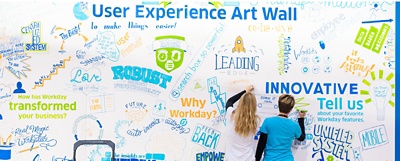What does all of this innovation mean for our customers?
Schlampp: At the highest level, it’s all about delivering the best possible experience for our customers, which really stems from when Dave [Duffield] and Aneel [Bhusri] founded Workday more than 15 years ago. Their vision was to reimagine enterprise software with people at the center. Technology has obviously evolved since then and so have our users, so our big focus right now is on finding new ways to improve the way that users interact with Workday.
I’ve also been incredibly proud of the team’s ability to deliver new innovations that are helping our customers navigate these challenging times. For example, by listening to our customers and staying laser-focused on their needs, we knew that certain capabilities within Workday People Analytics were needed now to help customers address various workforce issues associated with COVID-19 and diversity. Since our Analytics team leverages a continuous delivery methodology, we were able to accelerate the release of that product and get these key capabilities into our customers’ hands faster than originally planned.
Additionally, we pulled forward the availability of Workday Help and Workday Journeys, two solutions that extend the power of Workday People Experience and enhance our ability to deliver hyper-personalized experiences to employees. To give you an example, a number of our customers, after going live on Workday Journeys, created COVID-19 Journeys, centered around supporting remote employees during a crisis and returning to work. In one example, 95 percent of the users who interacted with the journey updated their emergency contact info, which proved extremely critical to the customer in terms of knowing how to support their people during a crisis.
But it doesn’t stop there. During the last several months, we’ve had customers lean on Workday to close their books 100 percent virtually, run payroll for more than one million workers, and conduct up to 30 times more forecasts and scenarios than we see in a typical week. And by partnering closely with our Technology and Customer Experience teams, we’ve been able to quickly develop more than 100 custom solutions, too. In short, Workday was made for times like these.
Chakraborty: Machine learning is a big focus for us. We are past the hype curve and are actively infusing machine learning into the foundation of all of our applications and service delivery to drive value to the end customer. Our machine learning-enabled products and features rely on blending technology with human oversight—to augment and guide the decisions that the software may be suggesting.
While the benefits of machine learning are boundless and often highly visible to the user, there are other areas of innovation geared at delivering an optimal customer experience that aren’t as visible, but are just as critical. I’ll use that term again here—it’s the invisible innovations that enable things like resiliency, scalability, availability, performance, and security, such as our ML-based account protection technology designed to intelligently detect anomalous activity within our customers’ Workday tenant. Finding new and better ways to ensure that our customers can seamlessly run their business has always been a priority for us, but given everything happening in the world today, it’s become more important than ever.
One way we do this is through our relentless focus on what I call personalization-at-scale. While we often talk about personalization in terms of the user experience, we also apply the concept to our service delivery. Each Workday customer is unique and we work to understand their business as it is and how it changes over time. We can adjust and deliver resources based on individual customer’s workloads and how they operate, informed by the specific timing of their business. We have automated processes in place to monitor and adjust hardware capacity, with human oversight to ensure we are responding to customers’ needs as quickly as possible–ideally and often before they even notice.
We believe Workday should be the one constant that our customers can rely on and from a technology perspective, we are focused on providing a platform that does just that.
As you both look into the future, what are some of the key areas of innovation that your teams will be focused on in this ever-changing world?
Chakraborty: From a technology perspective, we’re going to continue to push the envelope in many of the same areas that we’ve already discussed. We’ll continue to emphasize our focus on the invisible innovations for our service delivery to become even more predictive in supporting our customers’ highly elastic workloads, and embed machine learning into all of our products.
We will also further enable our customers to leverage the capabilities of Workday to enhance their world outside of Workday with products like Workday Extend and Workday Integration Cloud, and we’ll continue to innovate at the architecture level to seamlessly support massive scale with rock-solid security so that our customers can focus on innovating for their business rather than operations.
Schlampp: There is one more very important thing I’d like to add to that. In addition to supporting our customers during COVID-19, we also know that creating a more diverse workforce is a top priority for all of our customers—as it should be. So, a big area of emphasis for us will be to help our customers leverage Workday to support their belonging and diversity efforts. We’ll have more to share in this area in the coming weeks.








